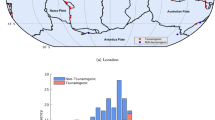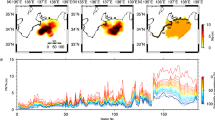Abstract
The present study proposes a methodology to generate stochastic slip field with desired probability structure and spectral characteristics. The characterization utilizes 100 tsunamigenic and 130 non-tsunamigenic slip models available in the SRCMOD database. First, the cumulative distribution function (CDF) of marginal slip distributions is obtained. Then, it compares the estimated CDFs with nine standard distribution functions based on model fitting criteria like Akaike Information Criterion, mean squared error, correlation coefficient, and QQ plots. The analysis showed that the majority of slip distributions follow generalized Pareto or truncated exponential distribution functions. For the parameters of CDF estimated from slip fields, an empirical relation is proposed as a function of magnitude (Mw) to predict the corresponding values. As the next step, to understand the correlation structure of the slip field, semi-variograms are estimated along strike and along downdip for all rupture models considered in the study. A total of nine theoretical variogram models is compared with the semi-variogram of each slip field. From the analysis based on model fitting criteria, most of the slip field is observed to follow a stable variogram model. An empirical equation is developed to predict the sill and range of stable variogram function for a given Mw. Then, an iterative method based on translational field theory is proposed to obtain an ensemble of non-Gaussian slip fields for a given Mw and type of source. The generated sample fields from the proposed method match with the prescribed non-Gaussian distribution and variogram structure. In the sequel, the method estimates the variogram and the corresponding spectral density of the underlying Gaussian field according to translation field theory. The scaling relations and the proposed iterative methodology can be used to obtain an ensemble of possible earthquake slip fields.













Similar content being viewed by others
Data availability
The Matlab codes for the generation of non-Gaussian slip field are available for research purposes from the authors
References
Akaike H (1973) Information theory and the maximum likelihood principle in 2nd International Symposium on Information Theory (BN Petrov and F. Cs ä ki eds.). Akademiai Ki à do, Budapest. Google Scholar
Andrews D (1976) Rupture propagation with finite stress in antiplane strain. J Geophys Res 81 (20):3575–3582
Bocchini P, Deodatis G (2008) Critical review and latest developments of a class of simulation algorithms for strongly non-Gaussian random fields. Probab Eng Mech 23(4):393–407
Brune JN (1970) Tectonic stress and the spectra of seismic shear waves from earthquakes. J Geophys Res 75(26):4997–5009
Davies G, Horspool N, Miller V (2015) Tsunami inundation from heterogeneous earthquake slip distributions: evaluation of synthetic source models. J Geophys Res: Solid Earth 120(9):6431–6451
Deodatis G, Micaletti RC (2001) Simulation of highly skewed non-Gaussian stochastic processes. J Eng Mech 127(12):1284–1295
Dhabu AC, Sugumar S, Raghukanth STG (2019) Characterization of strong motion generation regions of earthquake slip using extreme value theory. Pure Appl Geophys 1–26. https://doi.org/10.1007/s00024-019-02136-0
Dhanya J, Gade M, Raghukanth STG (2017) Ground motion estimation during 25th April 2015 Nepal earthquake. Acta Geodaetica Geophys 52(1):69–93
Dhanya J, Raghukanth STG (2018) Ground motion simulation for earthquakes in sumatran region. Current Sci 114(8):1709–1720
Dreger DS, Huang M-H, Rodgers A, Taira T, Wooddell K (2015) Kinematic finite-source model for the 24 August 2014 south Napa, California, earthquake from joint inversion of seismic, gps, and insar data. Seismol Res Lett 86(2A):327–334
Fabozzi FJ, Focardi SM, Rachev ST, Arshanapalli BG (2014) The basics of financial econometrics: tools, concepts, and asset management applications. Wiley, New York
Geist EL (2002) Complex earthquake rupture and local tsunamis. J Geophys Res Solid Earth 107 (B5):ESE 2-1–ESE 2-16
Goda K, Mai PM, Yasuda T, Mori N (2014) Sensitivity of tsunami wave profiles and inundation simulations to earthquake slip and fault geometry for the 2011 Tohoku earthquake. Earth Planets Space 66(1):105
Goda K, Yasuda T, Mori N, Maruyama T (2016) New scaling relationships of earthquake source parameters for stochastic tsunami simulation. Coast Eng J 58(3):1650010–1
González F, Geist EL, Jaffe B, Kânoġlu U, Mofjeld H, Synolakis C, Titov VV, Arcas D, Bellomo D, Carlton D et al (2009) Probabilistic tsunami hazard assessment at Seaside, Oregon, for near-and far-field seismic sources. J Geophys Res: Oceans 114(C11):C11023. https://doi.org/10.1029/2008JC005132
Grigoriu M (1998) Simulation of stationary non-Gaussian translation processes. J Eng Mech 124 (2):121–126
Guatteri M, Mai PM, Beroza GC, Boatwright J (2003) Strong ground-motion prediction from stochastic-dynamic source models. Bull Seismol Soc Am 93(1):301–313
Haskell NA (1969) Elastic displacements in the near-field of a propagating fault. Bull Seismol Soc Am 59(2):865–908
Hartzell SH, Heaton TH (1983) Inversion of strong ground motion and teleseismic waveform data for the fault rupture history of the 1979 Imperial Valley, California, earthquake. Bull Seismol Soc Am 73 (6A):1553–1583
IBC I (2009) International building code International Code Council. Inc. (formerly BOCA ICBO and SBCCI)
Kramer SL (1996) Geotechnical earthquake engineering in Prentice–Hall International Series in Civil Engineering and Engineering Mechanics. Prentice-Hall, New Jersey
Lavallée D, Archuleta RJ (2003) Stochastic modeling of slip spatial complexities for the 1979 Imperial Valley, California, earthquake. Geophys Res Lett 30(5):49–1–49-4. https://doi.org/10.1029/2002GL015839
Lavallée D, Liu P, Archuleta RJ (2006) Stochastic model of heterogeneity in earthquake slip spatial distributions. Geophys J Int 165(2):622–640
Lavallée D, Miyake H, Koketsu K (2011) Stochastic model of a subduction-zone earthquake: sources and ground motions for the 2003 Tokachi-oki, Japan, earthquake. Bull Seismol Soc Am 101(4):1807–1821
Lekshmy PR, Raghukanth STG (2019) Stochastic earthquake source model for ground motion simulation. Earthq Eng Eng Vib 18(1):1–34
Mai PM, Beroza GC (2000) Source scaling properties from finite-fault-rupture models. Bull Seismol Soc Am 90(3):604–615
Mai PM, Beroza GC (2002) A spatial random field model to characterize complexity in earthquake slip. J Geophys Res: Solid Earth 107(B11):ESE–10
Mai PM, Spudich P, Boatwright J (2005) Hypocenter locations in finite-source rupture models. Bull Seismol Soc Am 95(3):965–980
Mai PM, Thingbaijam K (2014) Srcmod: an online database of finite-fault rupture models. Seismol Res Lett 85(6):1348–1357
Mavroeidis GP, Papageorgiou AS (2003) A mathematical representation of near-fault ground motions. Bullet Seismol Soc Amer 93(3):1099–1131
Oglesby DD, Mai PM (2012) Fault geometry, rupture dynamics and ground motion from potential earthquakes on the North Anatolian Fault under the Sea of Marmara. Geophys J Int 188(3):1071–1087
Raghukanth STG (2010) Intrinsic mode functions of earthquake slip distribution. Adv Adapt Data Anal 2(02):193–215
Raghukanth STG, Sangeetha S (2016) A stochastic model for earthquake slip distribution of large events. Geomat Nat Hazards Risk 7(2):493–521
Sepúlveda I., Liu PL-F, Grigoriu M, Pritchard M (2017) Tsunami hazard assessments with consideration of uncertain earthquake slip distribution and location. J Geophys Res: Solid Earth 122 (9):7252–7271
Sherman M (2011) Spatial statistics and spatio-temporal data: covariance functions and directional properties. Wiley, New York
Shields M, Deodatis G, Bocchini P (2011) A simple and efficient methodology to approximate a general non-Gaussian stationary stochastic process by a translation process. Prob Eng Mech 26(4):511–519
Shinozuka M, Deodatis G (1996) Simulation of multi-dimensional Gaussian stochastic fields by spectral representation. Appl Mech Rev 49(1):29–53
Somerville P, Irikura K, Graves R, Sawada S, Wald D, Abrahamson N, Iwasaki Y, Kagawa T, Smith N, Kowada A (1999) Characterizing crustal earthquake slip models for the prediction of strong ground motion. Seismol Res Lett 70(1):59–80
Song SG, Dalguer LA (2013) Importance of 1-point statistics in earthquake source modelling for ground motion simulation. Geophys J Int 192(3):1255–1270
Thingbaijam KK, Mai PM (2016) Evidence for truncated exponential probability distribution of earthquake slip. Bull Seismol Soc Am 106(4):1802–1816
Thingbaijam KKS, Martin Mai P, Goda K (2017) New empirical earthquake source-scaling laws. Bull Seismol Soc Am 107(5):2225–2246
Webster R, Oliver MA (2007) Geostatistics for environmental scientists. Wiley, New York
Wells DL, Coppersmith KJ (1994) New empirical relationships among magnitude, rupture length, rupture width, rupture area, and surface displacement. Bullet Seismol Soc Amer 84(4):974–1002
Acknowledgments
We would like to thank the reviewers, Martin Mai, and the other anonymous reviewer, for their insightful comments and suggestion which helped in improving the quality of presentation of this work.
Author information
Authors and Affiliations
Corresponding author
Additional information
Publisher’s note
Springer Nature remains neutral with regard to jurisdictional claims in published maps and institutional affiliations.
Electronic supplementary material
Below is the link to the electronic supplementary material.
Rights and permissions
About this article
Cite this article
Dhanya, J., Raghukanth, S.T.G. A non-Gaussian random field model for earthquake slip. J Seismol 23, 889–912 (2019). https://doi.org/10.1007/s10950-019-09840-3
Received:
Accepted:
Published:
Issue Date:
DOI: https://doi.org/10.1007/s10950-019-09840-3




